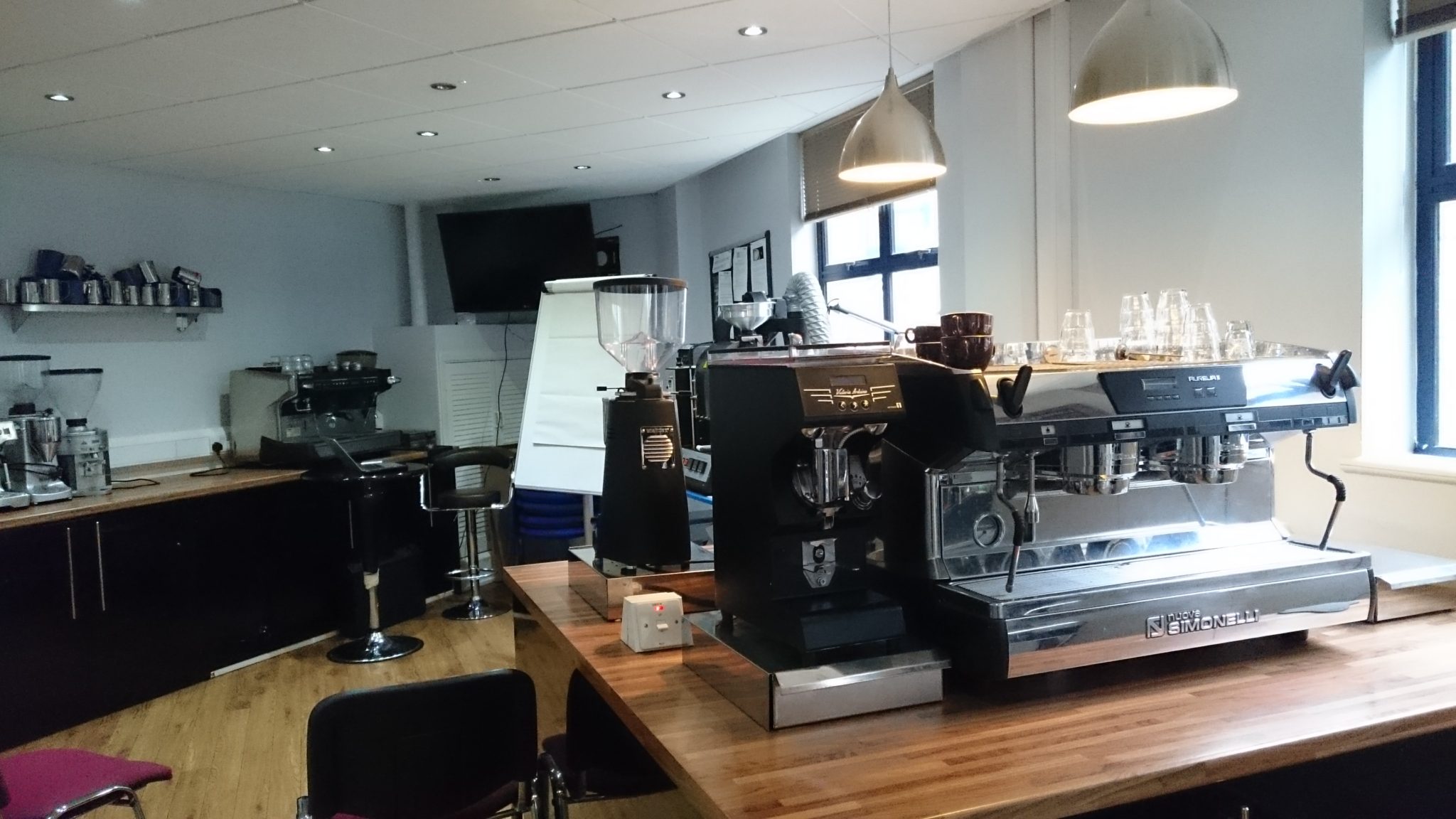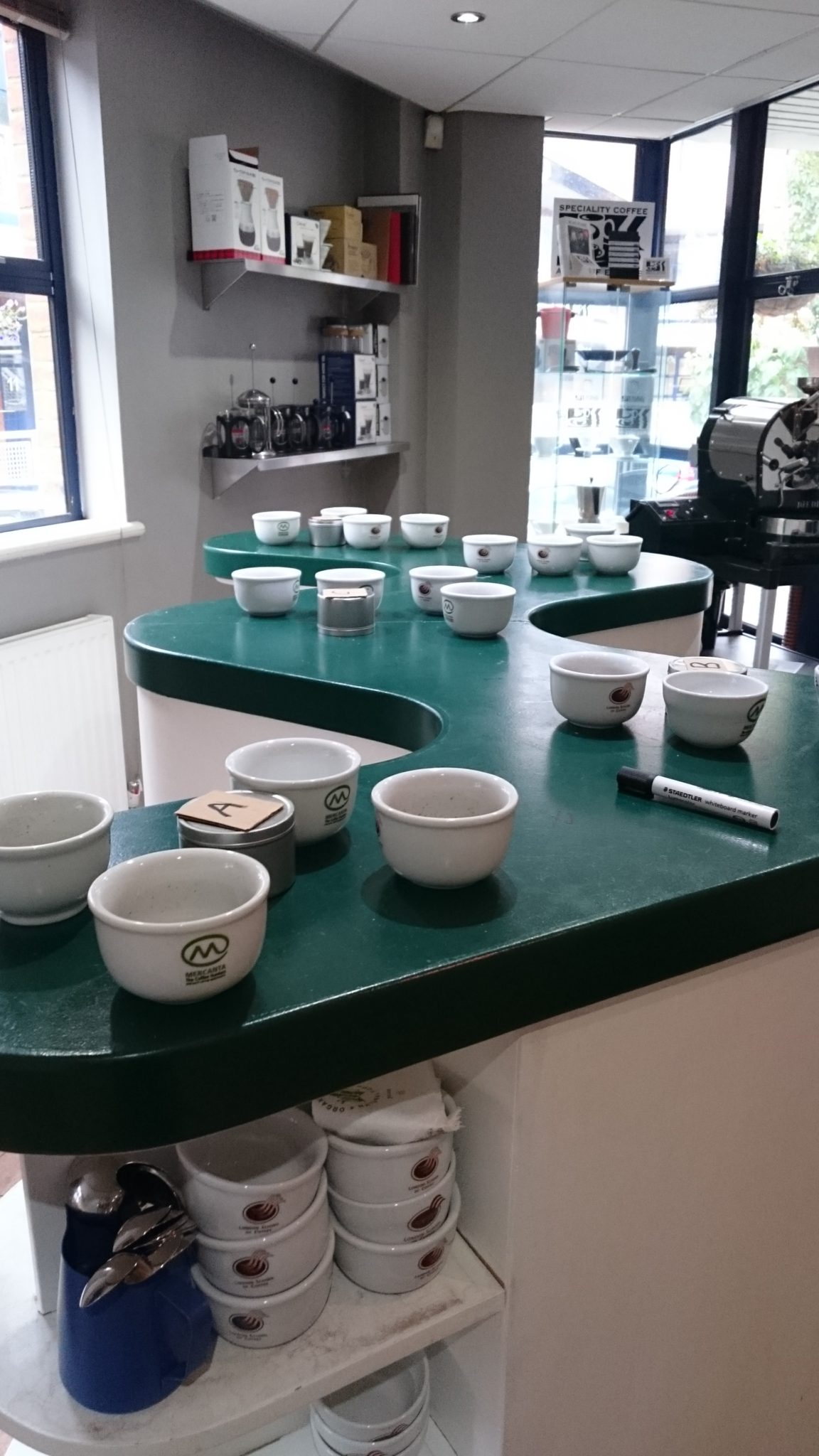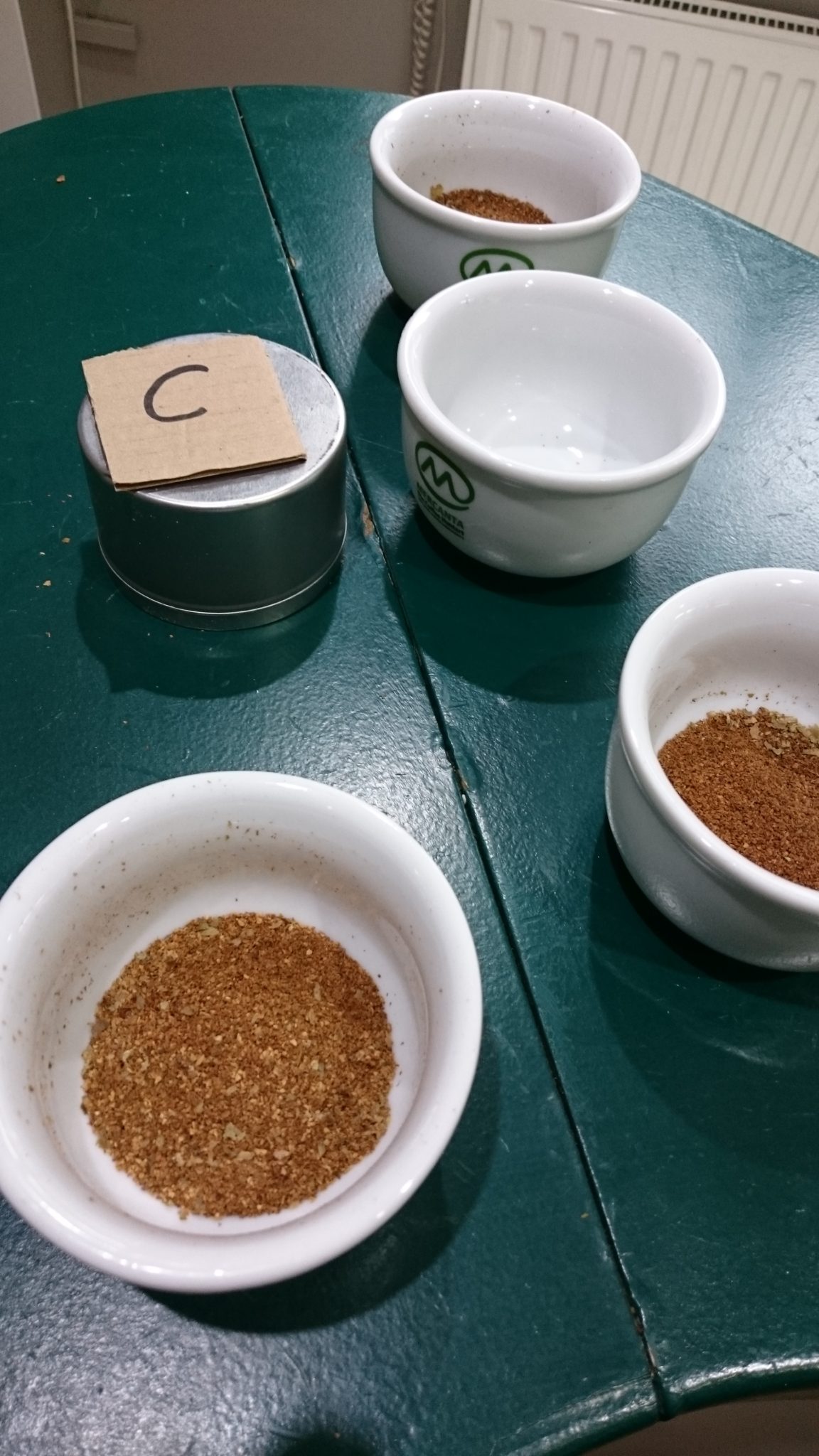
Continuing my training extravaganza, the day after the first day of my tea course I set off on a grey morning to travel out to the London School of Coffee in Kingston Upon Thames for their Introduction to Cupping and Sensory. I arrived to find only the instructor, the lovely and very enthusiastic Daisy Rollo of Coffea Arabica, and for a while it looked like it was going to be a private course until one other person turned up.
We started by going through the five basic tastes – bitter, sour, salt, sweet and umami – and although I had done the same exercise only the day before at the UK Tea Academy course I still had to think about sour versus bitter. (I may not be cut out to be a taster. Thankfully my day job is still translation.) Daisy also covered the importance of smell in what we think of as taste, with smell receptors in the back of the nose contributing everything other than the five basic tastes. She emphasised that training can significantly improve the ability to taste, so there may be hope for me yet! We also talked about the influence of external factors, even the colour of the room and lighting – things that have nothing to do with taste – and how they can affect the experience. (There’s a great Science Friday segment about colour and perception of wine.)
Daisy then produced a Nez du Cafe aroma kit and challenged us to figure out what we were smelling. I’ve seen a few kits like this before (there are some for sake as well, and wine and whisky) so I could guess what they might be, but still struggled to place them. The other student also found that he came up with associations for some of the smells – like home, baking, warmth – but not with the name of what he was smelling. You often hear that smell is very tied to memory but it was interesting to see it in action like this – you ask your mind for the name of a substance and it comes back with “smells like Christmas”.
At least I did better than I did on the fruit tastings at Mame, getting a few right and close for a few others. Daisy covered what the smells mean in the context of assessing coffee, such as the sour, musty “potato” aroma that indicates insect damage, especially in beans from Rwanda, and the “earth” smell of natural process coffee not turned frequently enough during drying, which allows the cherries to become mouldy.
We then moved on to talk about what influences the taste of coffee: origin, elevation, species and variety, farming practices, processing, drying, roasting and brewing. When you think of all that, it’s no wonder that coffee has the huge range of tastes that it does. Even the same variety of the same species of coffee plant can produce a different taste if grown in another place, because of the influence of soil, water and climate. Another factor that I hadn’t appreciated was elevation – similar to tea, some plants thrive at lower altitude and others need to be up high. For coffee, Coffea arabica likes to be at altitude whereas the more widely cultivated Coffea robusta grows happily at sea level. Daisy pointed out that elevation also affects other factors, such as rate of growth and therefore the amount of sugar and other chemicals, along with density which in turn determines how the bean is roasted. In general, coffee grown at lower altitude has a simpler range of flavours and aromas, with coffee grown higher up coming out with more acidity and complexity – she claimed you could taste the distance from sea level even in the same plantation from the acidity. And there isn’t just arabica and robusta to consider – each species has a huge number of varieties that will affect flavour – and varieties are often chosen for reasons other than flavour, such as disease resistance or tolerance to the effects of climate change.

Next was farming practices, everything from what agricultural chemicals are used to how the plants are spaced and pruned. One critical aspect was picking, and making sure the coffee cherries are picked at just the right time. After that was processing – natural or dry processing where the fruit around the coffee bean (really a seed) is left on, washed or wet processing where it is washed off, plus the infinite variations of “honey” processing that lie between, leaving some but not all of the fruit around the bean. Daisy ran through a long list of defects that can be caused by inadequate processing – drying too fast or too slow, too long in storage.
Finally we looked at roasting and brewing, and unbeknownst to all of us we were about to come across a great example of doing it wrong, plus a bonus one for storage. The other student had just been on a roasting course and got into a detailed discussion about roast profiles – I didn’t mind in the least as I had side-tracked the discussion plenty of times already with my own personal interests, like genetics and sustainability.
We looked at the Speciality Coffee Association tasting wheel, which starts off in the centre with types of flavour like “sweet” or “nutty” and gets more specific as it radiates out to “molasses” or “hazelnut”. Daisy emphasised, as Emi and Mathieu do at MAME, that there’s no right or wrong about tasting, and the wheel is only a prompt – it’s perfectly valid to find a taste or aroma that’s not on there. She also pointed out that the flavour profile of a coffee can dictate the best way to brew it – a very acidic coffee might be lovely brewed in a cafetiere, but undrinkable as an espresso.

Next was cupping, in the standardised format used by the Speciality Coffee Association. We helped Daisy measure and grind about 30 different coffees, weighing out the ground coffee into standard size cups and heating water to the specified temperature, smelling the dry ground coffee before adding the water to let them brew for the required time. She explained that this standardised procedure made it possible to compare coffees against each other, and to compare evaluations done in different places at different times. It’s also used throughout the production process, with the farm, exporter and importer using it to identify defects and check quality, and the roaster, barista and enthusiasts using it to assess quality and create blends. In the latter case, tasters are looking for fragrance or aroma, acidity, body, flavour, aftertaste/finish and balance. We also reviewed the scoring system used, where any coffee that scores above 80% is deemed to be “speciality”.
One of the coffees… was bizarre. Incredibly light brown, it smelled like popcorn. It even tasted like popcorn. I didn’t know if I had come across something rare and exceptional, but Daisy clearly wasn’t too happy with it. She called the office and asked one of the roasters to come down as she had some questions.
When someone did arrive later on, it was clear they weren’t interested. The light brown “popcorn” coffee was just seriously under-roasted. “It’s a robusta. What do you expect?” There were three samples of one coffee processed in three different ways for us to taste the difference between processing methods, but she didn’t think the differences were clear. “What do you expect from coffee stored for six months in paper bags?” Daisy tried to point out that these were samples for a sensory class and therefore totally unfit for purpose (and the conversation took place in the classroom in front of the two students who had paid and given up their time for said class) but just got shrugs.
The guy did come back later to take samples back to the roasting lab, so I don’t know if someone said something to him, but it was really frustrating. Maybe the courses are just a side business for them and therefore not a priority, but it wasn’t a good experience to see how little the people supplying the coffee cared.
This course isn’t an SCA-approved one, so it doesn’t give you any points towards their training qualifications. We discussed the role of professional organisations and how, after they get past the initial work of promoting the profession, they tend to exist for their own sake instead of continuing to serve their members. (Translation, I’m looking at you.)
It was still a great session, and Daisy is a very knowledgeable and passionate educator. I dropped in to the office after the class to collect my certificate, at which point it began to rain heavily. I hadn’t thought to pack a coat or umbrella, but one of the women in the office took pity on me and very kindly drove me back to the station – a lovely end to a great day!
